The Important Differences Between Sourdough And Soda Bread
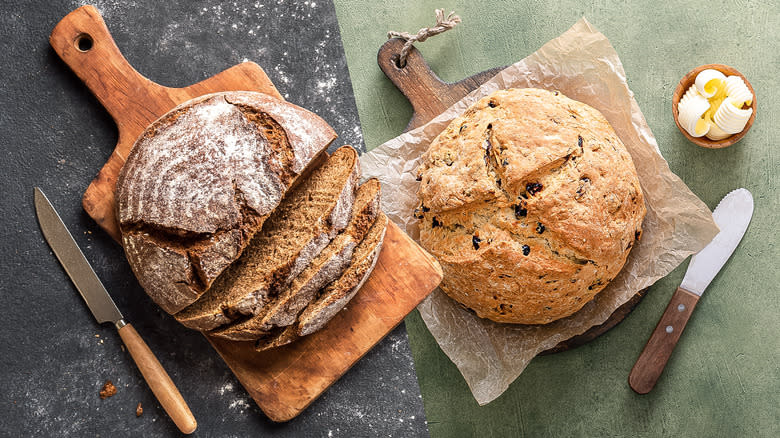
Typically round, crusty, and scored on top, sourdough and soda bread look pretty similar at first glance. But open them up, take a taste, and you'll see they're very different. The two types of bread have distinct histories, methods of preparation, and flavors. In some ways, they're just about as different as two types of bread can get. However, there are a few similarities. Both breads rely on one key ingredient: lactic acid. Lactic acid is an organic compound produced through fermentation. It's found in kimchi, yogurt, pickles, and other fermented foods and provides a sour, tangy flavor.
In soda bread, which is typically made from flour, baking soda, and buttermilk, the lactic acid in the buttermilk reacts with the baking soda, creating bubbles that help the bread rise. Lactic acid is present in sourdough starter — the fermented natural yeast that gives sourdough its characteristic flavor — too. Basically, lactic acid bacteria produced through fermentation put the "sour" in "sourdough."
Look deeper, and you'll find similarities in the differences, too. Both sourdough and soda bread help us understand the role of bread in human culture. Both speak to the ways that bread baking has changed over time. If you're a beginner baker, learning about — and baking — the two types of bread will offer you a crash course in the interplay between ingredients and the process of leavening bread. Compare techniques, and you'll learn lessons you can apply to baking at large.
Read more: 15 Best Knife Brands, Ranked
What Is Soda Bread?
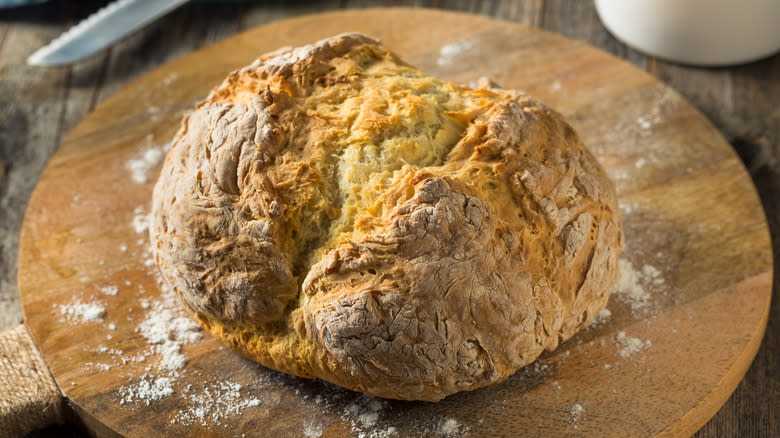
When Americans talk about soda bread, they typically associate it with Ireland. But the definition is more muddled than it might seem. While the basic ingredients of flour, baking soda, and buttermilk generally stay the same, soda bread varies significantly from place to place. The Irish soda bread that pops up in American bakeries around Saint Patrick's Day is often sweet, made from white flour, and jazzed up with raisins, currants, or orange zest. Sometimes, bakers will add eggs to the mix. While you can find similar loaves in some Irish bakeries, they would've traditionally been luxury items. The most common form of Irish soda bread is called brown bread, and it's still widely popular today.
Brown bread is made with wholemeal flour, a softer, coarser version of the wholewheat flour found in American grocery stores. Brown bread tends to have fewer ingredients, but it's still satisfying in its own right. The bread is generally shaped into round loaves and scored with a deep cross. Legend says that the cross lets the devil out of the bread; from a culinary perspective, it helps the loaf cook all the way through.
In Northern Ireland, farls, a form of soda bread made with white flour and eggs, are ubiquitous. Cooked on a griddle and turned on both sides, they look more like thick pancakes or English muffins than a loaf. While this article focuses on Sothern-style soda bread, they're still part of the soda bread tradition.
What Is Sourdough?
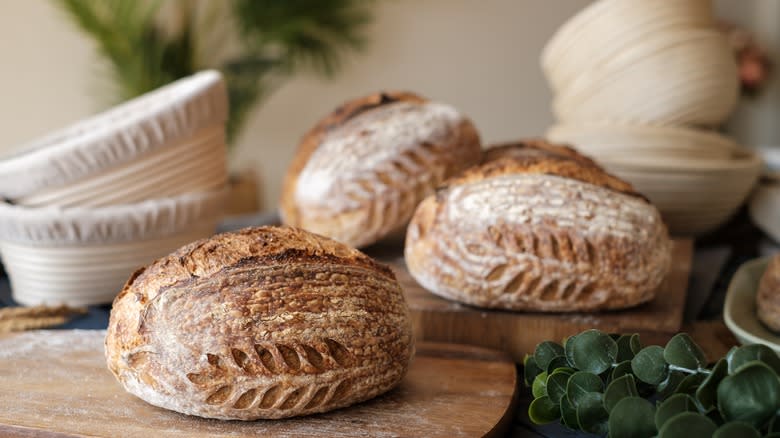
Sourdough is the oldest form of leavened bread: historians believe that practice dates back over 5,000 years to ancient Egypt. Thousands of years ago, someone left a mixture of flour and water out too long and decided to bake the bubbly result rather than waste it — inventing sourdough in the process.
Like soda bread, sourdough is made without commercial yeast. The leavening comes from a sourdough starter, a living colony of natural yeast — not the stuff you buy at the store. When flour and water are left to sit, the mixture attracts live yeast and lactic acid from the surrounding environment. This grows into a colony, which needs regular feedings with additional flour and water. But, when you properly care for sourdough starter, it can live indefinitely. When yeast feeds, it releases carbon dioxide. As the gasses bubble up, the mixture rises. Stir a bit of sourdough starter in with more flour and water to form a dough, let it sit, and the colony will eventually take over and raise the dough. The result is airy on the inside and thick on the outside, with a tangy lactic acid taste characteristic of sourdough bread.
With such a long history, sourdough comes in many different forms. You can find sourdough made from a wide variety of flours, each with its unique taste. Some sourdoughs incorporate sweet ingredients, others lean savory. Leftover starter provides new opportunities. Sourdough fans often incorporate it into waffles, cakes, muffins, and more.
Soda Bread Is A Relatively New Invention
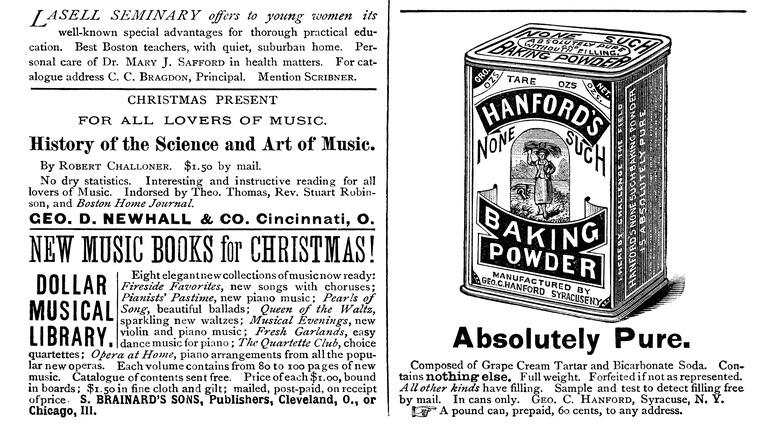
Nowadays, we tend to take baking soda for granted. Along with baking powder, it's a staple of every kitchen; it's used as a leavening agent in scones, cookies, and biscuits. But up until relatively recently — within the past 200 years — bakers had to make do without baking soda or baking powder. Instead, they relied solely on yeast and makeshift chemical leaveners.
Native Americans used potash, or potassium carbonate, to leaven bread; the technique quickly spread to early European colonists. Like baking soda, potash, a substance derived from hardwood ashes, produces carbon dioxide when mixed with acids. But potash is caustic and foul-smelling, not necessarily the tastiest thing to add to bread. In the early 19th century, precursors to baking soda started to appear. The first reference to soda bread in Ireland appeared in an 1836 issue of Farmer's Magazine and called for super-carbonate of soda, one of those early precursors.
It wasn't until later in the 19th century, when baking soda became readily available, that soda bread took off. Irish wholemeal flour has a low gluten content, rendering yeast nearly useless. However, after baking soda hit the shelves, bakers found that the newfangled leavening agent worked like a charm. Soda bread fell out of favor among Irish cooks around the beginning of the 20th century. However, upscale hotels revived the bread during the 1960s. In the decades since, it's become mainstream and is now a vital part of Irish culinary culture.
Sourdough Has A Much Longer History

When those ancient bakers first discovered the secrets of sourdough, they invented a process that would carry on through human history. In Greece, bread was reserved for the rich; in Rome, bakers enjoyed a special social status. Over time, bakers developed new techniques, and tastes shifted towards less acidic breads. Still, many countries across Europe continued to make sourdough, cementing it as a staple throughout the continent.
But, while sourdough may have lived on in pockets of European culture, it wasn't popular among 19th-century Americans. That changed during the gold rush. Commercial yeast was hard to find, so prospectors turned to sourdough. Soon, the bread became as much a symbol of mining culture as the pickax: prospectors were even nicknamed "sourdoughs." These loaves were rough and foul-smelling, but still provided a valuable source of food. In San Francisco, this jumpstarted a sourdough culture that remains to this day. While the popularity of sourdough has waxed and waned over the past century, nostalgia and a desire to connect with history kept tradition (and starters) alive.
You can't mention sourdough without acknowledging its resurgence in the early days of lockdown when baking became a popular way to stave off boredom. With yeast in short supply and enough time to take on the labor-intensive process, bakers turned to sourdough. Even years past the height of the pandemic, lively online communities still give advice and debate techniques — ensuring that sourdough will live on for generations to come.
Sourdough And Soda Bread Have Different Textures
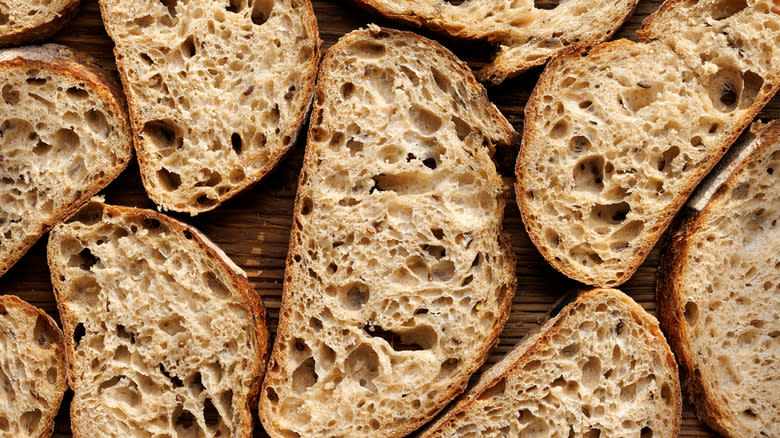
With so many types available, there is no "standard" for either sourdough or soda bread — but as a general rule, the texture couldn't be more different. While some types of sourdough are denser than others, bakers generally prize an airy, open structure. The perfect loaf is full of evenly spaced large-but-not-too-large air bubbles. Bite into a slice, and you'll find it moister and chewier than commercial bread, with a tough, leathery crust.
Standard Irish soda bread also has a tough outer crust, but the inside is dense and crumbly without an air bubble in sight. Moisture is key to good soda bread: thanks to the dense texture, an overly dry loaf can be a struggle to eat. Think of the ideal texture as something akin to a cake or scone: after all, cakes and scones are typically leavened with chemical leaveners, too. With such a crumbly texture, soda bread doesn't make for good sandwich bread — but slathered with a thick smear of butter, it is an excellent snack.
Sourdough And Soda Bread Have Different Tastes
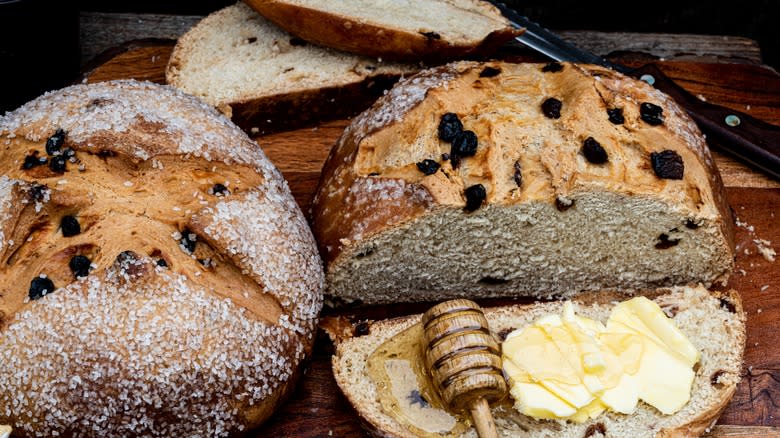
Sourdough tastes, well, sour. But exactly how sour sourdough tastes depends on a number of factors. Different types of flour attract different types of bacteria, which have a major impact on flavor. Rye-based starters attract a kind of bacteria that produces both lactic acid and acetic acid, which gives the bread an extra-sour taste. Starters made from wheat flour attract a kind of bacteria that only produces lactic acid, resulting in a subtler flavor.
Environment makes a difference, too. Bacteria that thrive in warmer weather tend to make for sweeter sourdough; a cold snap could mean an extra tangy loaf. Loaves baked in San Francisco are rich in a specific kind of bacteria; many bakers believe that the city's unique environment makes for a taste that can't be replicated anywhere else.
Soda bread isn't not sour — after all, it still contains that lactic acid that gives sourdough its signature taste. Baking soda can help neutralize the sour taste, but sometimes adds a certain bitterness of its own. The simplicity of traditional loaves highlights the complex, nutty flavor of wholemeal flour, a quality that's lacking in soda bread made with white flour. However, white flour makes for a beautiful blank slate. If you opt to use white flour — either due to personal preference or because whole meal flour is hard to come by in American grocery stores — consider gussying up your soda bread with honey, dried fruit, or savory cheeses.
Sourdough Uses High-Gluten Flour, Soda Bread Uses Low-Gluten Flour
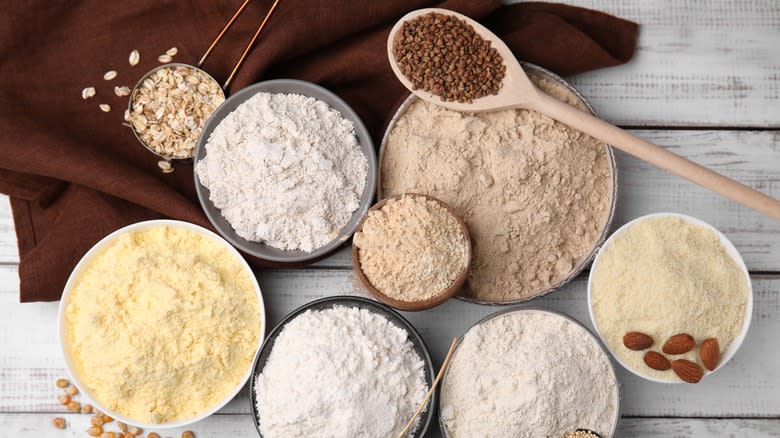
Any baker worth their bread knows the importance of gluten. Picking a flour with the right amount of gluten for the bread you're making is key to getting the perfect loaf, and the types of flour used for sourdough and soda bread are at opposite ends of the gluten spectrum. The soft wholemeal flour traditionally used for Irish soda bread is low in gluten; even recipes that call for white flour typically recommend using low-gluten cake flour instead of bread flour. Too much gluten will leave you with a stiff, chewy loaf.
Sourdough bakers, meanwhile, tend to prefer higher-gluten flour, especially if the end goal is an airy, open crumb. However, sourdough isn't a high-gluten bread, either. Bacteria break down the gluten during the fermentation process, so the final loaf ends up with a fairly low gluten content — even if it started with a higher-gluten flour. The longer a sourdough loaf ferments, the lower the gluten content will be.
Neither traditional soda bread nor sourdough are completely gluten-free, but they're both good options for people with mild gluten intolerances. However, people with celiac disease or more severe gluten intolerances should avoid them — or look for versions made with gluten-free flour.
Sourdough Takes A Long Time, Soda Bread Takes A Short Time
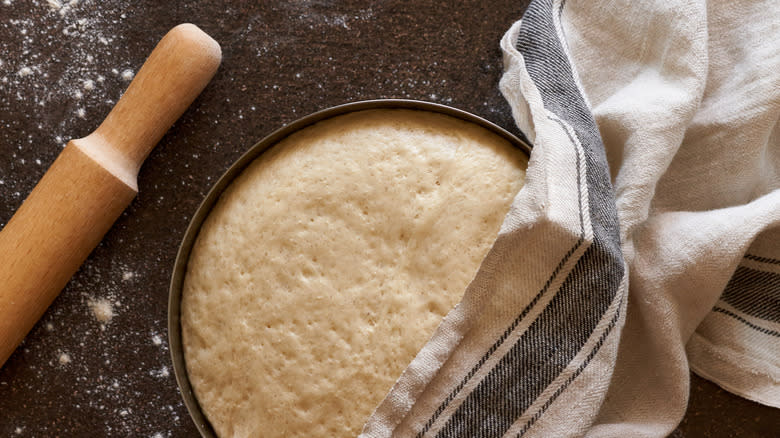
One of the biggest differences between soda bread and sourdough is cooking time. Soda bread lives up to its "quickbread" title — while standard yeasted bread takes a few hours, you can make a loaf of soda bread in under 45 minutes. But if soda bread is the 100-yard dash of the bread world, sourdough is an ultramarathon. Loaves take between 12 and 14 hours, and that's if you already have a starter. If you want to make your own sourdough starter, you're looking at an additional seven to 14 days.
Why does sourdough take so long? Well, the yeast found in nature comes in many different varieties, or "strains." Commercial yeast, the yeast you'd find in the grocery store, is made from a strain chosen for its ability to ferment. The yeast is fermented on an industrial scale, and the process has been honed over 150 years to produce the best possible results.
The natural yeast in sourdough starter is a grab bag: since it's coming from the environment around you, you're not getting the refined stuff you're used to. Natural yeast is much less potent and therefore takes much longer to do its thing. However, the speed of commercial yeast comes with a trade-off: time helps the bacteria in natural yeast break down gluten, draw out minerals, and give the bread its famous funky flavor. The lesson? Good things take time — unless those things are soda bread.
Read the original article on Tasting Table


